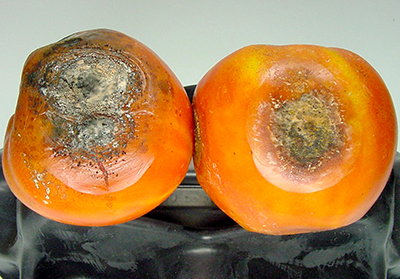Tomato anthracnose: When those prized, ripe tomatoes go bad
Ripe tomatoes are more prone to skin damage, which could lead to anthracnose.

For many gardeners, the end of August and beginning of September are the big times for harvesting ripe tomatoes from their home gardens. As is the usual case, those same excited gardeners have planted too many plants and a great number of tomatoes are being picked almost daily. What many of these gardeners are finding is these ripe tomatoes are rotting rapidly. When the gardeners looked at their plants, the leaves and stems looked good, the fruit was good, but what happened to the lovely tomatoes?
The answer is anthracnose (Colletotrichum coccodes). This is fungus that causes fruit to rot and can also be responsible for a high mold count in canned tomatoes. Tomatoes have a relatively tough skin, but as the fruit ripens, the flesh of the tomato below the skin becomes softer. At this point, it is easier to damage the fruit. It is still possible to damage green tomatoes, but they do not exhibit the sunken spots until they ripen. The riper the tomato, the more likely anthracnose will develop.
Tomatoes growing on plants or sitting on the kitchen counter develop small, slightly depressed, rounded spots. The spots increase in size and sink in more deeply. Often, the sunken areas develop a pattern of concentric rings. The sunken areas darken and usually small, dark dots, which are the fruiting bodies of the fungus, develop in the center of the sunken area. In humid, warm weather, the spots with the fungus can exude masses on slimy tan or salmon-colored spores. As the spots grow, they can coalesce and bigger areas develop. On ripe fruit, a spot or lesion can develop in five to six days.
Anthracnose is a disease of just the tomato fruit. It does not mark the leaves or stems – the plant is healthy. Late blight (Phytophthora infestans) has been prevalent in many areas in the state this year, and unlike anthracnose, the entire plant is affected. The fruit has tan, bubbled patches of leathery skin, both on green and red tomato fruit. The leaves have brown spots, often with a purplish cast. Affected areas become water-soaked, turn dark brown to purple-black, shrivel and die. Stems of plants can be affected. As the stems are girdled by the dark, purple-brown lesions, the plant collapses rapidly and is dead in a few days to a week. Decaying vines have a foul, moldy odor and the plant dies rapidly. For pictures of late blight symptoms so as not to confuse symptoms with anthracnose, see “Tomato late blight pressure is high” from Michigan State University Extension.

Two tomato fruit with the disease anthracnose. Photo by Paul Bachi, University of Kentucky Research and Education Center, Bugwood.org
So how did the skin get damaged on the tomato? It could happen from a hail storm. It could happen from blowing sand in an unmulched garden, essentially sandblasting the fruit. It could happen by picking tomatoes and piling them into a bag or basket. It could happen from human or pet contact with the plants. In other words, it could happen in many ways.
This has been a humid summer. The spores are out there, waiting for a tomato injury. The “tomato-meter” is running. So if anthracnose will develop in five to seven days, you now know how long that sweet, ruby-colored fruit can sit before it is eaten or processed. Don’t let anthracnose ruin your tomato party.



 Print
Print Email
Email